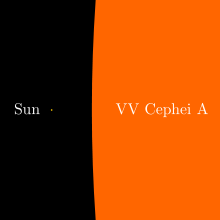VV Cephei
| Astrometry | |
|---|---|
| Distance | 2,400 within 20 percent[1][foot 1] ly |
| Absolute magnitude (MV) | -9 |
| Characteristics | |
| Spectral type | M2 Iab[2] |
| Details | |
| Mass | 25-40[1][foot 1] or 100 M☉ |
| Radius | 1600-1900[1][foot 1] R☉ |
| Luminosity | 275,000-575,000[1][foot 1] (bolometric) L☉ |
| Temperature | 3300-3650 or 3200[1] K |
| Observation data Epoch J2000 Equinox J2000 | |
| Constellation | Cepheus |
| Right ascension | 21h 56m 39.144s[3] |
| Declination | +63° 37′ 32.01″ |
| Apparent magnitude (V) | 4.91[1] (Naked eye) |
VV Cephei, also known as HD 208816, is an eclipsing binary star system located in the constellation Cepheus, approximately 2,400 light years from Earth.[1][foot 1]
A red hypergiant fills the system's Roche lobe when closest to its companion blue star, the latter appearing to be on the main sequence. Matter flows from the red hypergiant onto the blue companion.
VV Cephei A


VV Cephei A, the low-density hypergiant, is one of the largest stars known, and believed to be the second largest star in the Milky Way after VY Canis Majoris and third largest known after the hypergiant WOH G64 in the Large Magellanic Cloud. It is of spectral type M2 and is poorly estimated at approximately 1,600–1,900 times the Sun's radius, or approximately 2,227,200,000 to 2,644,800,000 km across. If placed in the center of the solar system, the hypergiant would likely extend past the orbit of Jupiter and approach that of Saturn. VV Cephei is 275,000-575,000 times more luminous than the Sun.[1] As is true for many red hypergiants, a stellar wind flows off the system at a velocity of approximately 25 kilometers per second.[2] VV Cephei A's mass estimated from its orbital motion is about 100 solar masses, but its luminosity suggests a mass 25-40 solar masses. Consequently, the actual mass is unknown. This star also is know by SAO 19753, HD 208816, HIP 108317.[3]
VV Cephei B
VV Cephei B is suspected of being a B class main sequence star.[1] But it has been classified from a giant (Type III)[4] to a dwarf (Type V).[1] The semi-major axis of the binary orbit is approximately 25 AU,[1] with the separation between the components varying between 17 and 34 AU due to the eccentricity.[1] VV Cephei B is much denser than VV Cephei A.[1] This likely causes the swollen supergiant VV Cephei A to distort into a teardrop shape.[1] VV Cephei B is estimated to be about 10 times the Sun's diameter and about 100,000 times its luminosity. The orbital period of the system is 7430 days (20.3 years). The eclipse lasts about 1,300 days, and is total for about a year and a half. The midpoint of the last eclipse was in early January 1998.[5]
See also
| <<< 1. VY Canis Majoris | 3. Mu Cephei >>> |
Footnotes
- ^ a b c d e f g Size, mass and luminosity estimates are all considerably uncertain due to insufficient knowledge of the Cephei star system: Professor Kaler writes "in truth we really do not know". Its distance cannot be measured from parallax, instead it is derived from its assumed membership in the Cepheus OB2 association, but this is also not certain. Other methods give a range of sizes between 1000 and 2200 that of the Sun, but these too are confounded by the fact that the star is not spherical, which leads to overestimates. (J. Kaler)
References
- ^ a b c d e f g h i j k l m n Professor James B. (Jim) Kaler. "VV CEP (VV Cephei)". University of Illinois. Retrieved 2009-07-12.
- ^ a b Bauer, Wendy Hagen (2007). "An Ultraviolet Spectral Atlas of VV Cephei during Total Eclipse". Astrophysical Journal Supplement Series. 171: 249–259. doi:10.1086/514334. Retrieved 2010-03-14.
{{cite journal}}: Unknown parameter|coauthors=ignored (|author=suggested) (help) - ^ a b "VV Cephei". SIMBAD Astronomical Database. Retrieved 2010-03-16.
- ^ Habets, G. M. H. J.; Heintze, J. R. W. (1981). "Empirical bolometric corrections for the main-sequence". Astronomy and Astrophysics Supplement. 46: 193–237. Retrieved 2009-09-21.
{{cite journal}}: Unknown parameter|month=ignored (help)CS1 maint: multiple names: authors list (link) Page 211 "Table I" #137-138 - ^ W. H. Bauer, P. D. Bennett, & A. Brown 2007. See especially their Figure 1, p. 250.
External links
- Space.Com
- Universe Today
- Google Video (Scale of VV Cephei compared to Earth Video)
- VV Cephei at Kempten observatory
- Aladin image of VV Cephei

